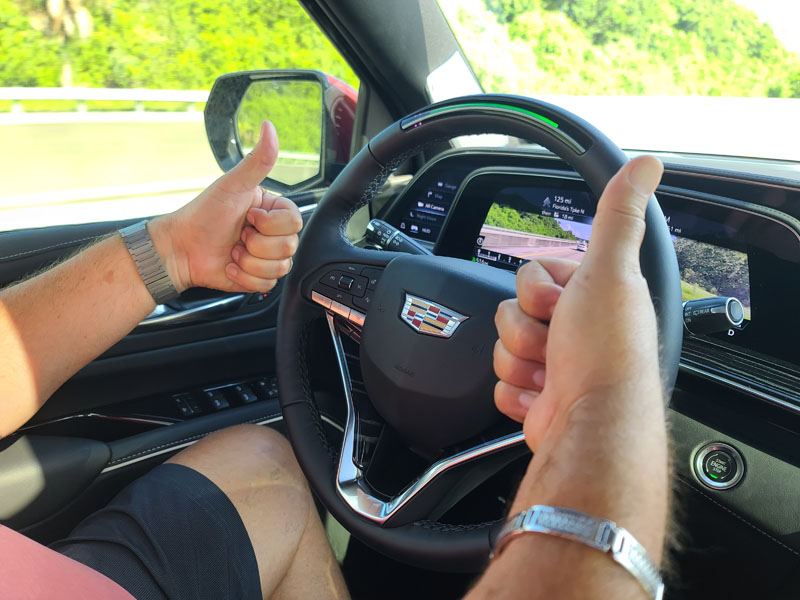
ARTICLE/REVIEW – By now, pretty much everyone has heard of Tesla’s Autopilot – their version of driver assistance. It’s been in the news a lot with crashes (not necessarily the system’s fault), video of sleeping drivers careening down a Los Angeles freeway, and more. Plus, in its current iteration, the system requires you to have your hands on the steering wheel, even though it is doing the steering. That doesn’t seem like much of an advantage.
Enter Super Cruise from that other little auto company you may have heard of – General Motors. Yes, GM. The company that was at the forefront of the decline of the U.S. auto industry a few decades ago by missing the fact that consumers wanted smaller and more fuel-efficient cars. But GM is back and in a big way, at the leading edge of auto tech like electric vehicles, and now, semi-autonomous driving. The lawyers determined it has to be called “driver assistance”, but the bottom line is that when Super Cruise is doing its thing, it is doing the driving. We have a new vehicle with Super Cruise and recently took a trip from The Villages, Florida, where we live, to Port Everglades in Ft. Lauderdale for a cruise. A week later, we made the return trip. It was about 270 miles each way and a perfect opportunity to let Super Cruise chauffeur us to and from the cruise port. Let’s see how it went.
What is Super Cruise? Here’s the official description from GM:
Super Cruise™ is the first true hands-free driving-assistance technology for compatible roads. Super Cruise utilizes advanced technologies to provide the ease and convenience of hands-free driving, even while changing lanes, thanks to Lane Change on Demand, offered on select Super Cruise-equipped vehicles.
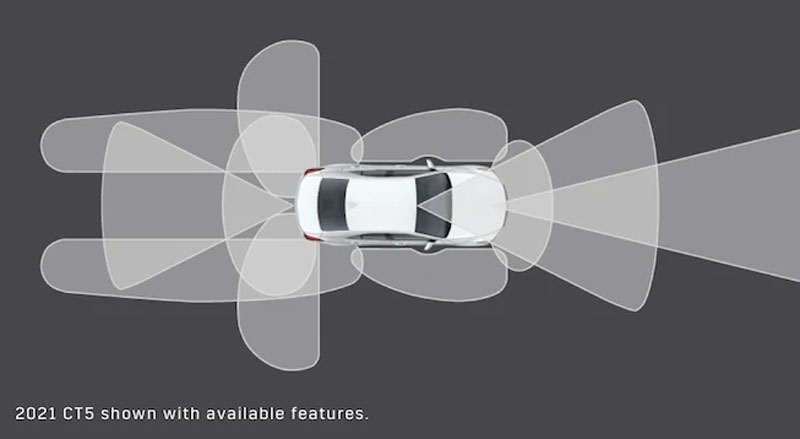
Real-time cameras, sensors, and GPS, along with LiDAR precision map data, provide Super Cruise with the data it needs to keep you centered in the lane, even through curves and lane deviations.
Super Cruise works with the vehicle’s adaptive cruise control to maintain vehicle separation. It also uses a series of cameras and sensors to determine other vehicles that may be in front, to the side, or behind your vehicle. This allows the vehicle to perform lane changes on-demand as well as fully automatic lane changes when overtaking slower traffic. I’ve got to tell you, it’s pretty cool watching your car put the turn signal on, change lanes, pass, and then put the turn signal on and change lanes back.
There are five levels of vehicle automation:
- Level 0 – no automation
- Level 1 – driver assistance – like adaptive cruise control
- Level 2 – partial automation like steering and speed but the driver remains in control
- Level 3 – condition driving automation – this adds environment detection
- Level 4 – high driving automation – the vehicle or driver can intervene if things go wrong
- Level 5 – full automation – no driver intervention required
Super Cruise is considered a Level 2 system. We are still technically and legislatively a long way from Level 3, let alone Level 5. Rumor has it that Mercedes recently got a Level 3 approval in Germany, but here in the US, there still is nothing over Level 2.
Before we go any farther, you will note that in the photos and video, there are instances where my speed is slightly higher than the posted speed limit. I don’t condone nor encourage speeding. However, if you have ever driven on the Florida Turnpike, you know that driving at the speed limit is a recipe for an accident as it is essentially an unlicensed racetrack – you’ll see some of that in the video below. I set my speed so that I am in the middle, passing a few but generally getting passed by most.
Now, back to Super Cruise. Where does it work? Super Cruise only works on limited-access roads with no direct opposing traffic. Think highways. As of now, they have mapped over 200,000 miles of compatible roads in the U.S. and Canada with more on the way.
Super Cruise was available on multiple Cadillac models and is now also available on select GMC, and Chevrolet vehicles. Here is Cadillac’s page with details and a map of available roads.
It works with multiple sensors in the vehicle, adaptive cruise control, and connected services. That last part means that you do need a connected services contract with GM to use Super Cruise. GM includes three years with a new vehicle, but yet, it essentially is a subscription service that will generate GM a revenue stream in three years.
When you’re on a compatible road and have the requisite settings in place, the Super Cruise icon shows up in gray on the instrument panel. Center the vehicle in the lane and hit the Super Cruise button on the steering wheel and the icon will turn green, indicating that Super Cruise is in control.
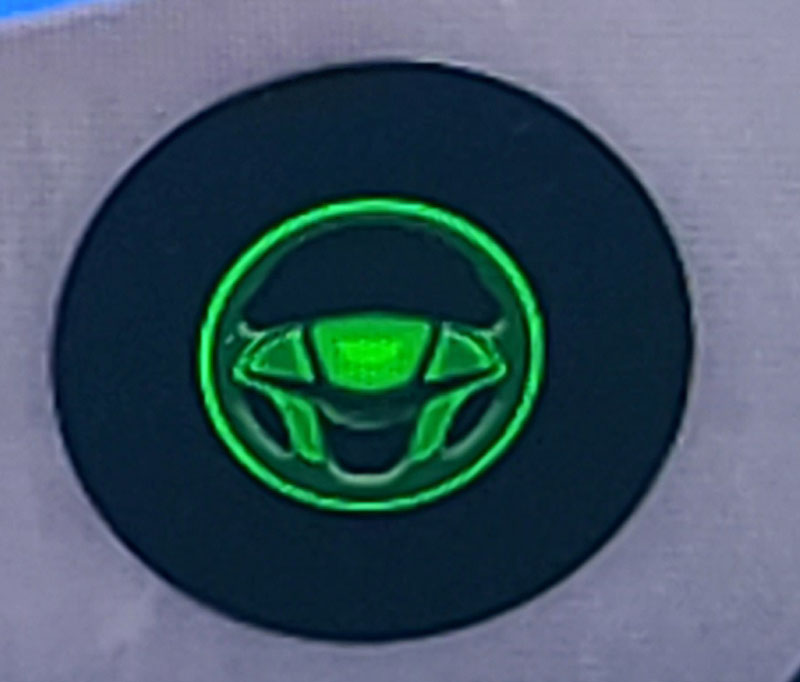
You also get a prominent indication at the top center of the steering wheel.
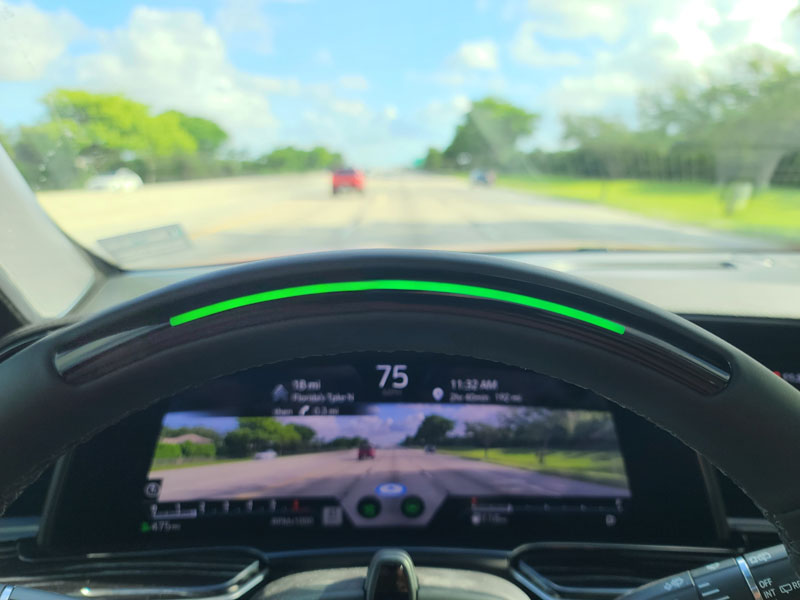
Look at the bottom of the photo above. See that bump right in the middle on top of the steering column? That’s how the vehicle knows that you are paying attention. That camera, coupled with infrared emitters on either side of the green bar on the steering wheel gives the vehicle a look at your eyes, even if you are wearing sunglasses. If you look away for more than a few seconds, the wheel blinks green as a warning. If you still don’t look, it flashes bright red, and a warning displays indicating that Super Cruise is disengaging and you need to take control. It also vibrates the driver’s seat cushion to get the driver’s attention. If the driver is incapacitated – a medical emergency, fallen asleep – whatever, Super Cruise will bring the vehicle to a controlled stop (in the lane!) and notify Onstar so that emergency services can be sent.
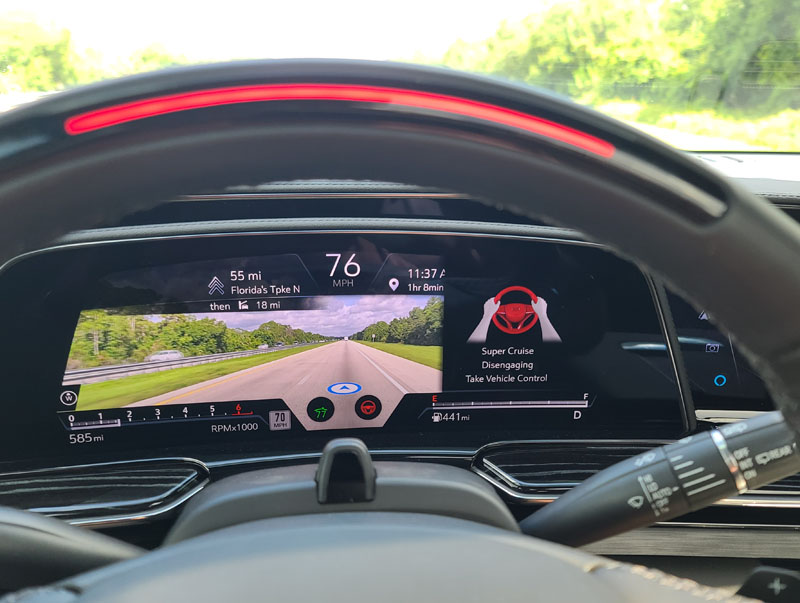
You can still control the vehicle manually with Super Cruise engaged. If you take control of the wheel, the bar will turn blue, indicating Super Cruise is still active but you are steering. Once you are centered in the lane again, it will turn green and take over.
If you bump the turn signal, as soon as it is clear, Super Cruise will execute the lane change for you.

If you are overtaking slower traffic, once a clearing is available, Super Cruise will change lanes on its own, using the turn signal and vibrating the seat on the side of the lane change. Super Cruise will execute a left lane change to pass and then a right lane change to return to the normal lane.
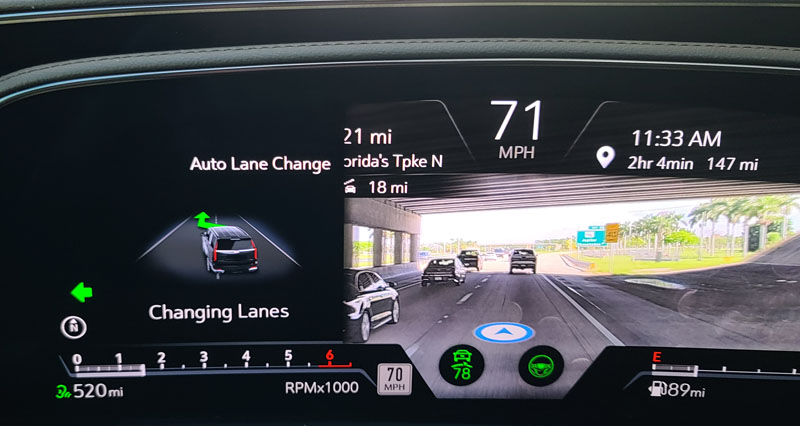
While automatic lane changes worked most of the time, there were times when adaptive cruise control just slowed me down but no lane change happened even though there was no traffic to my left. In those cases, I just bumped the turn signal, and away we went.
The same was true after passing. Most times, it did a lane change to the right, returning me to my original lane. But sometimes, it just left me hanging in the left lane until I bumped the turn signal. I couldn’t figure out a pattern as to why it did what it did.
One unexpected thing Super Cruise did was add speed. It happened when I was passing a vehicle, but doing so very slowly. Sitting in a driver’s blind spot is a dangerous thing. Super Cruise added two miles per hour to my speed until I was past the vehicle and then returned me to my set speed and changed lanes back to the right. How cool is that?
Here I am, relaxed and watching the miles roll underneath us, doing absolutely nothing but paying attention. I was surprised how much more relaxed I was versus driving, even with adaptive cruise control.
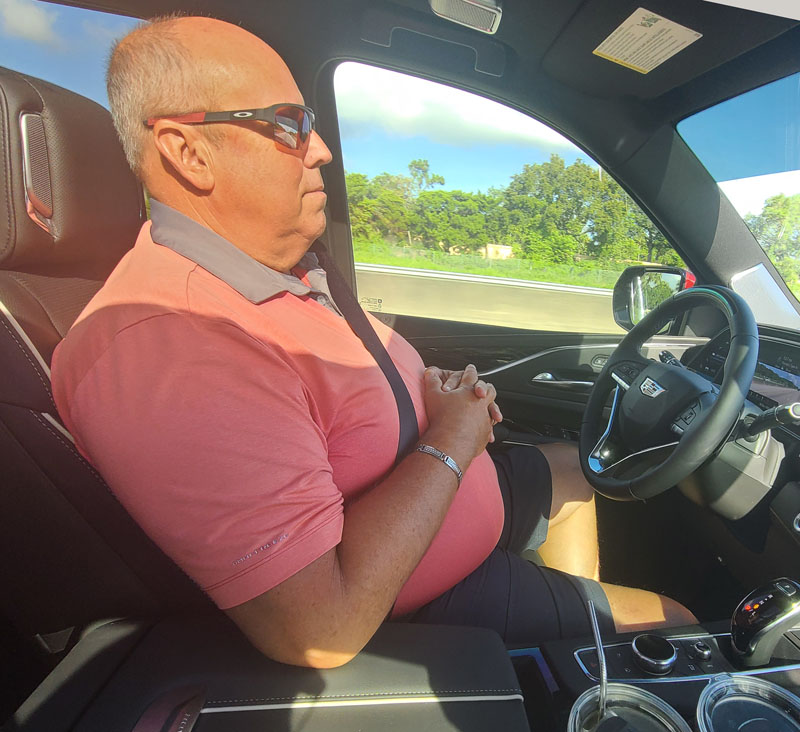
Stop-and-go traffic is a sweet spot for Super Cruise. Super Cruise will slow all the way to a stop automatically. When traffic starts moving in front of you, Super Cruise will start your vehicle as well.
Super Cruise errs on the side of being conservative. Aggressive drivers can whip in since Super Cruise leaves a gap between you and the vehicle in front. That gap can be set to far, medium, and near, but even in near mode, there is plenty of room for a jerk to cut you off. That is done for safety, so I get it and I’m OK with it. If I’m letting the car drive, I find that I am more tolerant.
Other issues are places where Super Cruise doesn’t work. On the Florida Turnpike, we hit a few short stretches where Super Cruise disengaged for lack of road data. One was in an area where the road has recently been rerouted. I understand that. The other, and longest stretch was on a regular stretch of turnpike with no construction or alterations. I don’t understand that one.
I did test out how well Super Cruise could tell if I was watching. With a passenger watching, so they could tell me to take control if necessary, I turned my head just enough so my eyes weren’t visible to the camera. Sure enough, in a few seconds, the wheel started flashing green. As soon as I turned back, it went back on solid and remained in control. Next, I looked down and the same thing happened. Finally, I looked ahead but closed my eyes. Once again, the camera detected it and as soon as I opened my eyes, it recognized that and all was good. All this happen while I was wearing medium-dark sunglasses.
Here’s a look at the system in action. It is two separate clips put together into one video. A couple of notes – see my comment on the speed above. About 43 seconds into the first clip, you’ll see what I was talking about with two vehicles nearly hitting my right rear bumper as they flew by me at 90+MPH, passing on the right while changing lanes at the last second. Super Cruise saw them and halted my automatic lane change. Also, you’ll see Super Cruise disengage at that point – that was because I had my camera unfortunately positioned between the eye-detection camera and my eyes, so it didn’t think I was paying attention. The video shows a couple of automatic lane changes. I never touched vehicle controls during filming – the vehicle was doing everything on its own. The flashing lights on either side of the green bar are the infrared emitters. They aren’t visible to the naked eye.
Suffice it to say that I am a fan. I’m looking forward to updates as more roads are mapped. In addition, data from more than seven million miles of Super Cruise driving is being continually analyzed to improve the programming. Those updates will be delivered over the air to vehicles.
This isn’t the only cool tech in the vehicle. It has an augmented reality view where the traditional instrument cluster is replaced with a forward camera view. When using the in-dash navigation, turn instructions are overlayed on the view, including flashing turn arrows. When driving at night, you can change the instrument cluster to a night-vision display. This can detect people and animals much farther away than the headlights can illuminate. When a body is detected, it is highlighted with a yellow box. Think about seeing a deer highlighted in the dash long before your headlights pick up their eyes! Of course, there is also a head-up display (HUD), placing pertinent driving data right on the windshield. A final nice tech touch is conversation enhancement where microphones and speakers are used to channel conversation from the far back seat to the front seats so that everyone can converse without yelling. Cool!
We have a long trip coming up from central Florida to Maine and back and I am looking forward to letting our vehicle treat me like Miss Daisy and drive me there. Of course, I’ll be in the front seat and will be paying attention, ready to take over, but it will be a considerably more relaxing trip.



Gadgeteer Comment Policy - Please read before commenting
How do you think this compares to Tesla?
Fair question. Unfortunately, since I’ve never owned a Tesla, I can’t speak from personal experience other than I know that at least in its current iteration, Tesla Autopilot requires your hands to be on the steering wheel, at least every few seconds, or it disengages. For me, that’s a deal-breaker. What’s the point of auto-steering if I have to have my hands on the wheel. The other difference is that Tesla promises operation on city streets where Super Cruise so far has not. Of course, Tesla has promised a lot and not delivered, so take that for what it’s worth.
Jimmy: I should have added that Super Cruise uses LiDAR-mapped roads whereas Tesla Autopilot uses cameras and sensors only and figures things out on the fly. This makes Super Cruise more accurate as it relies on precisely mapped data.
That is a nice review. I recently got a Chevy Bolt EV which unfortunately does not have super cruise. The EUV does. What model car do you have? The range for the EV and EUV are around 260 miles if you are not blasting along at 70mph or faster on a highway. Does your car have a longer range or did you have to make a pit stop to fast charge somewhere? If you have fast charged I am curious as to what the rates were that you paid. All of the type 2 chargers around here are free and any type three charger I can find seems to already have a car in it. Fortunately for me, the longest trip I have taken in a day was still within range and I was able to recharge fully overnight with my type 2 charger in my garage.
On a side note, I can say that the adaptive cruise on the GM seems way better than the adaptive cruise I had on my Audi. The GM will start to accelerate the moment you put the blinker on and get you past the car you are passing quickly. The Audi was on the more cautious side and I often had to push the gas pedal down manually to speed the car up in order to get out of the way of faster traffic.
Looks like Tesla offers Autopilot, Enhanced Autopilot and Full Self-Driving
https://www.tesla.com/support/autopilot
Jimmy: All still require hands on the wheel.
Yes, I’m aware of that… their title is a bit misleading, although the FSD is a beta.
Thanks, Lynn. My “charge” costs are a little over $4/gallon as this is not an electric vehicle – it is a 2022 Cadillac Escalade Sport. While we like the idea of electric vehicles and have had two Chevy Volts, until I can charge one as quickly and efficiently as I can pump 450 miles into the Escalade, for road trips, it just isn’t practical. If all your driving is city commuting, and you leave with a full charge every morning, electric makes a ton of sense.
Ah cool, I did not realize they were putting that feature in gas vehicles. Yea I won’t be using it for road trips. Even when we had gas cars, we often rented cars for long mileage trips. I will admit that Tesla has a ton more superchargers available should you wish to travel long distances.